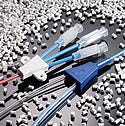November 2, 2009
Originally Published MPMN November/December 2009
BREAKTHROUGHS
Filler Enhances Safety, Comfort of Radiopaque Catheters
|
A bismuth subcarbonate radiopaque filler offers good dispersion, thereby enabling the fabrication of catheters with smooth, defect-free surfaces. |
Enabling plastic devices to fluoresce under x-ray, radiopaque additives such as bismuth subcarbonate are a necessary ingredient in the fabrication of catheters designed for minimally invasive (MI)procedures. But despite illuminating where in the body a device is located, bismuth subcarbonate fillers have left compounders in the dark for years in terms of the common surface defects they produce—until now. Foster Corp., a PolyMedex Discovery Group, has developed a bismuth subcarbonate radiopaque polymer-enhancement technology that it claims offers better performance and a smoother surface than competing fillers.
Despite its frequent use in MI applications owing to its high opacity, bismuth subcarbonate has been associated with surface defects attributed to its poor dispersion in plastics. “When you have poor dispersion of bismuth subcarbonate, you have an agglomeration of the filler that actually comes to the surface of the device,” explains Brian LaBrec, director of engineering. Although the bump is formed when the compound is introduced into the plastic, it becomes more pronounced during extrusion of the catheter.
“[The bump] causes a weakness in the device, so you can have a risk of premature failure in the market, and it could create a discomfort when being
inserted in the body,” LaBrec adds. The defect makes the product vulnerable to a blowout or weakening because it is a mechanical stress point. This problem has become prevalent enough, LaBrec notes, that physicians now often slide a finger across the surface of the device prior to use to ensure that there is not an imperfection. Should the device fail such a simple tactile test, physicians will return the defective product.
In addition to this rising demand from end-users, the need for better dispersion of bismuth subcarbonate is becoming more urgent as devices shrink. “As the market increasingly demands thinner-walled products and tighter tolerances, any type of poor dispersion becomes more pronounced at that step, and it limits the design and has a higher yield loss to OEMs,” LaBrec says.
With these concerns in mind, Foster set out to improve dispersion by focusing on the morphology, density, crystallinity, surface area, and particle size of bismuth subcarbonate. As a result, the company has introduced its bismuth subcarbonate filler as part of the Lo-Pro radiopaque medical compounds product line. The company believes that its additive offers significantly improved dispersion compared with competing fillers, thereby resulting in smoother surfaces and enhanced performance. “We feel that we have a differentiator here,” LaBrec stresses. “What we have found is much more compatibility and improved dispersion.”
Suited for use with most thermoplastics, the filler reportedly facilitates a more-stable extrusion process, which the company ascribes to the particle morphology and dispersion characteristics. The technology has also demonstrated the ability to maintain consistent polymer viscosity after compounding and extrusion, which, in turn, has produced good yields.
Foster Corp., a PolyMedex Discovery Group
Putnam, CT
www.fostercorporation.com
Copyright ©2009 Medical Product Manufacturing News
You May Also Like



